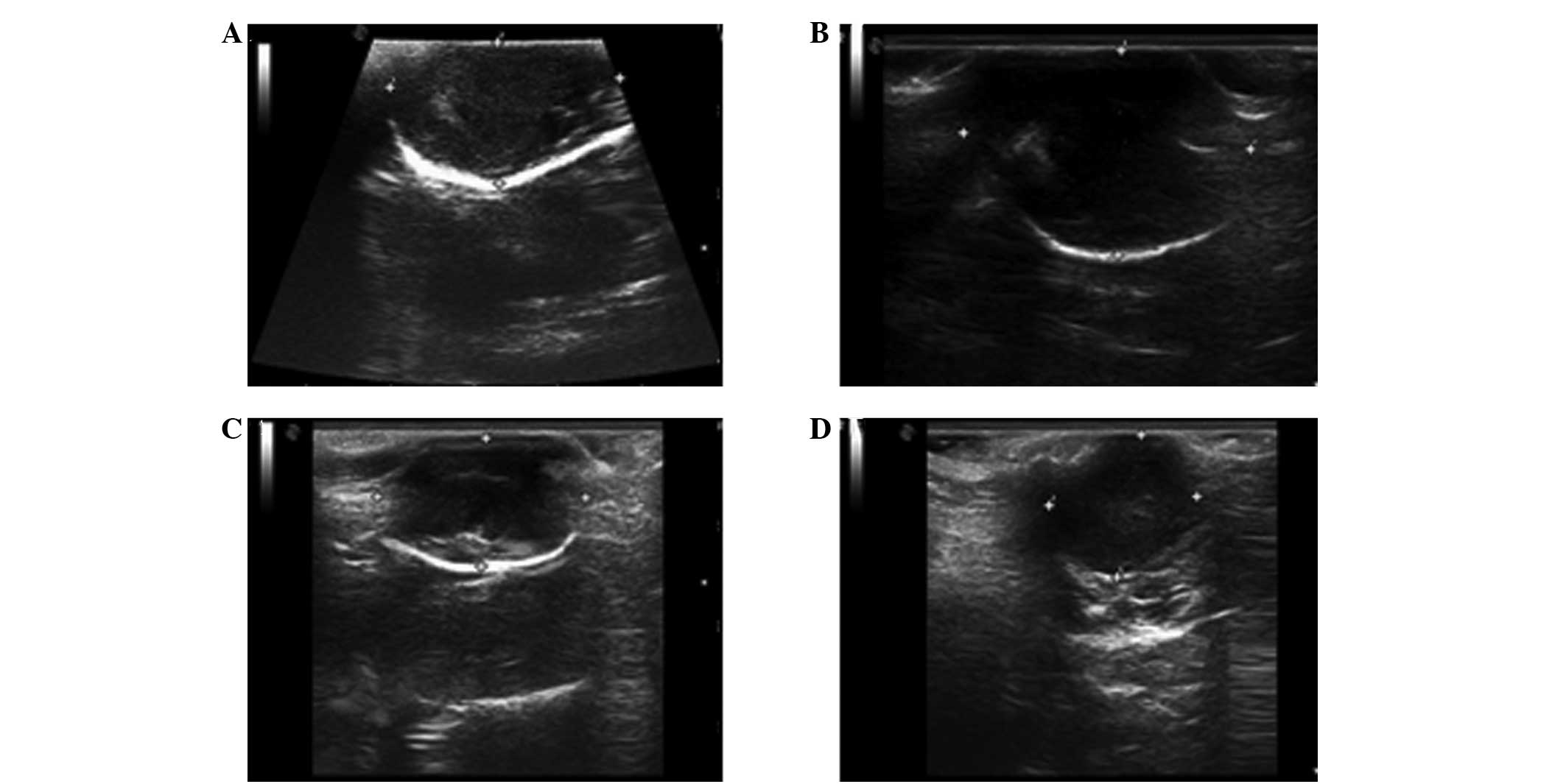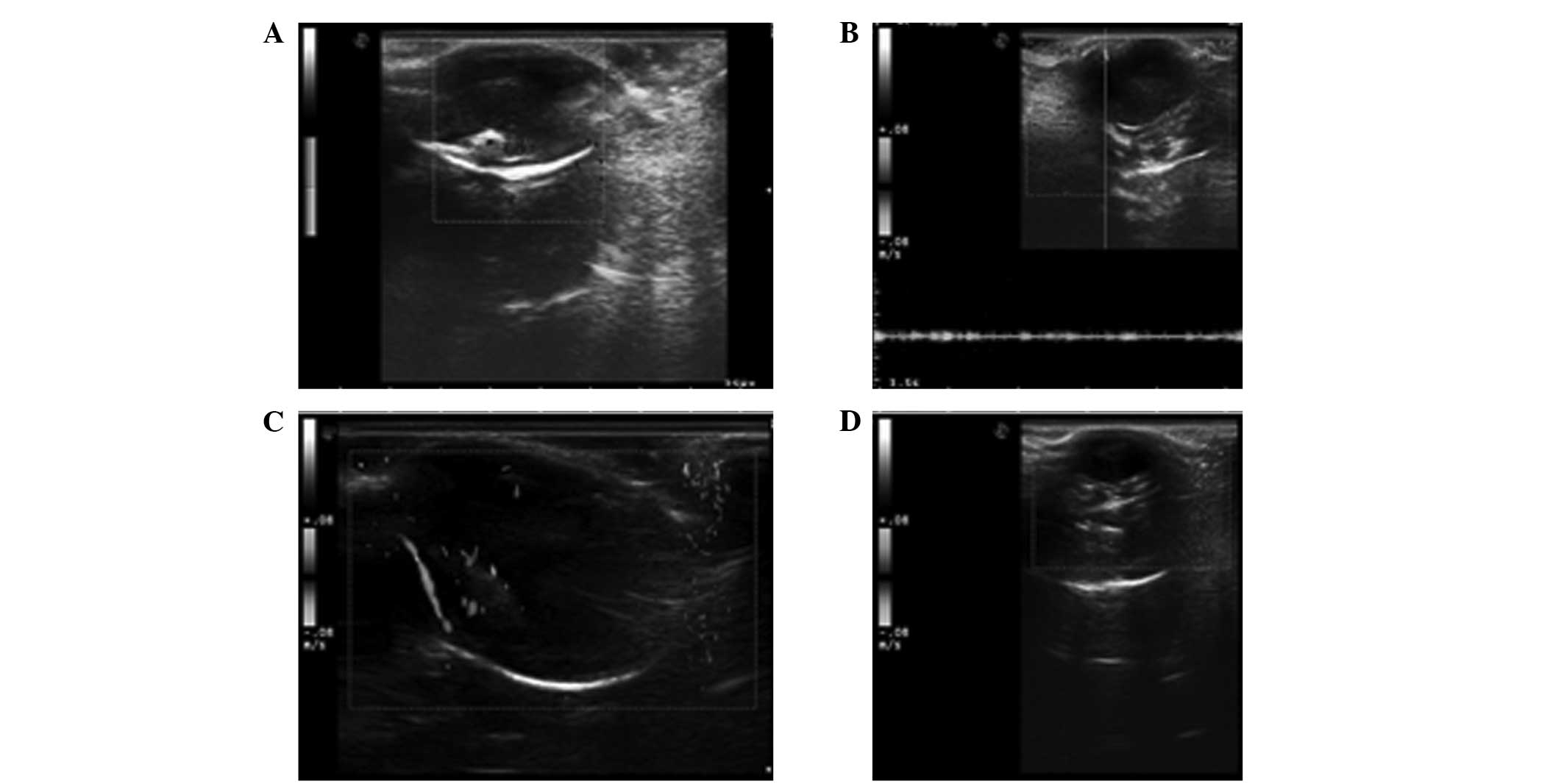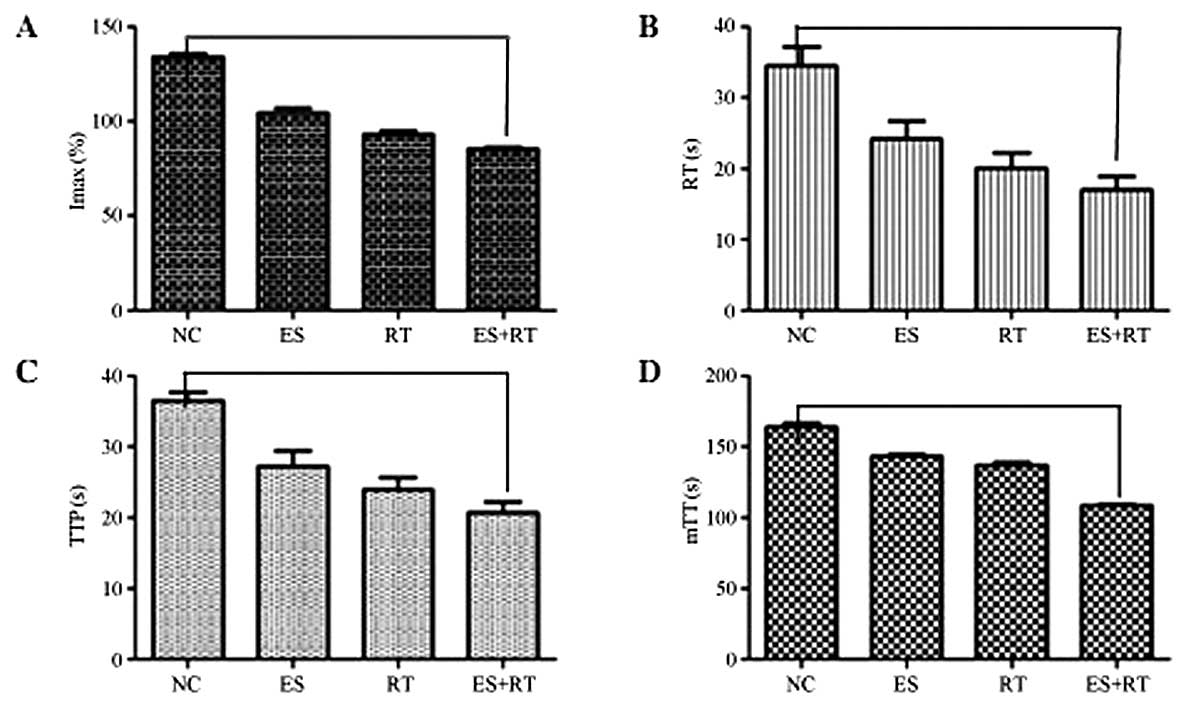Introduction
A previous study demonstrated that Endostar
(recombinant human endostatin) improves the efficacy of
radiotherapy in cell and animal experiments (1). Endostar, which has a synergistic
effect with radiotherapy, may act by inhibiting radiation-induced
hypoxia-inducible factor-1α and vascular endothelial growth factor,
as well as by upregulating aquaporin 1 expression (2). The vascular normalisation theory is
widely recognised; Endostar normalises tumour vascular structure
and function (3). Endostar
combined with radiotherapy significantly inhibits the growth of
Lewis lung cancer and may affect tumour angiogenesis. The present
study aimed to investigate whether normalised vessels strengthen
the role of radiation therapy of tumours by improving tumour tissue
perfusion, thereby reducing the tumour hypoxia.
In the present study, the method of visualisation
was contrast-enhanced ultrasonography. Intravenous injections of
SonoVue, a second-generation contrast agent comprising microbubbles
of sulfur hexafluoride, are widely used for abdominal and
superficial organ tumour imaging (4). The advantages of using SonoVue
include enhanced blood backscattering and a clearer blood flow
image. The echo of the contrast agent in the blood is uniform and
pseudomorphism is not easily produced (5).
The mechanical index (MI) of the ultrasound contrast
agent used in the present study is <0.15, which is lower than
that of microbubbles. Therefore, the energy of the ultrasound waves
when reflected not only achieves continuous harmonic imaging but
also reduces the disturbance of harmonics from the surrounding
normal tissue (6). Perfusion in
the tumour tissues of various treatment groups may be measured
through low MI images (7). In the
present study, this method was selected to visualize the changes in
tumour blood perfusion associated with various experimental factors
at different times. In addition, the targeting of tumour vascular
perfusion following the administration of antiangiogenic drugs and
radiotherapy was possible.
Materials and methods
Animals
In total, 192 specific pathogen-free female C57BL/6
mice weighing 17–20 g were used. Four of the mice had Lewis lung
cancer. The diameter of the lump in the left forelimb armpit was
~1.5 cm. The mice were reared in the Experimental Animal Center of
Renmin Hospital of Wuhan University (07203P; Wuhan, China). The
study was carried out in strict accordance with the recommendations
of the Guide for the Care and Use of Laboratory Animals of the
National Institutes of Health (8th edition). The animal use
protocol was reviewed and approved by the Institutional Animal Care
and Use Committee of Wuhan University.
Model and grouping
Lewis tumour-bearing mice were sacrificed by
cervical dislocation on a sterile bench. Mouse tumour homogenate
was stripped and cut into pieces. The living cell suspension was
used for subcutaneous inoculation of the tumour. The C57BL/6 mice
were subcutaneously inoculated to provide a tumour volume of 80
mm3. The mice were randomly divided into four groups as
follows: Blank control (control), Endostar (ES), radiotherapy (RT)
and Endostar combined with radiotherapy (ES + RT). For the control
group, each mouse was administered a subcutaneous injection of 0.2
ml saline for 14 days. For the ES group, each mouse was
administered a subcutaneous injection of 0.2 ml Endostar (Simcere
Pharmaceutical Group, Nanjing, China) for 14 days. Each mouse in
the RT group was subjected to 6 MeV electron irradiation with a
radiation dose of 2 Gy/day for five consecutive days (source to
skin distance, 100 cm) for a total dose of 10 Gy. In the ES + RT
group, each mouse was administered a subcutaneous injection of 0.2
ml Endostar for 14 days and concomitantly received radiotherapy
from day 1 to day 5 of the 14 days.
Image analysis
Contrast video was stored in DICOM format and
SonoLiver CAP software version 1.0 (TomTec Imaging Systems GmbH,
Unterschleissheim, Germany) was used for quantitative analysis.
Three regions of interest (ROI) were painted in the contrast
images. Boundary, lesion and reference ROIs were coloured blue,
green and yellow, respectively. The areas of depth of the lesion
and reference ROIs were equal. Enhanced level differences were
shown by the dynamic vascular pattern (DVP) curves and quantitative
parameters. The DVP curves reflected the change process of
enhancement level difference with time between the tumour and the
surrounding normal tissue.
Statistical analysis
SPSS version 17.0 statistics software (SPSS, Inc.,
Chicago, IL, USA) was used to analyse the data. Measurement data
are expressed as mean ± SD. Single-factor analysis of variance was
selected as the statistical method. P<0.05 was considered to
indicate a statistically significant difference.
Results
Ultrasonic observations of tumour size
and blood flow distribution
Two-dimensional ultrasonic observations of the
internal mouse tumour region showed hypoechoic and heterogeneous
changes. A clear boundary interval was observed in the normal
tissue around the tumour (Fig. 1).
Tumour growth was observed for 14 consecutive days and colour
Doppler flow imaging visualised the punctate, linear or branching
irregular signal distributions around the tumour and parts of the
interior region. The contrast signal was significantly increased
following contrast enhancement. Blood flow perfusion and regional
distribution changed as the tumour increased. The distribution of
the blood flow area was not consistent in the control group. In the
groups that were administered Endostar or radiotherapy alone,
decreased vascular enhancement in the tumour area was observed in a
circular distribution boundary. The enhanced region of blood flow
in the combined group was the strongest, given that the
experimental factors contributed to relatively normal tumour
neovascularisation (Fig. 2).
Analysis of the DVP curves
SonoLiver quantitative analysis software was used to
reconstruct a dynamic vascular model based on the parameters of the
level of difference between the tumour and the surrounding normal
tissue. Each point on the DVP curve reflects the change in the
level of difference with time of the enhancement between the tumour
and the surrounding normal tissue. DVP curves have an automatic
correction function, as they employ motion compensation to reduce
or eliminate the artefacts caused by the movement of the probe.
Based on the relationship between the opening of the
curve and trending of the DVP curve and the X axis, the DVP curve
of the focus area was divided into three types: Regression, not
subsidised and negative, which accounted for 63.41, 36.59 and 0%,
respectively (Fig. 3).
Quantitative parameters
Quantitative parameters differed among the groups
for peak strength, rise time, the time to peak and the mean transit
time of perfusion. The differences of peak strength, rise time,
time to peak and the mean transit time of perfusion in the ES+RT
group and control group were statistically significant (P<0.05;
Fig. 4).
Discussion
Since the late 20th century, worldwide studies have
achieved effective, quantitative blood flow imaging of experimental
canine myocardium through the application of ultrasound with the
analysis of parameters from microbubble refilling curves (8). The present study investigated whether
it was possible to clearly observe blood flow perfusion in
tumour-bearing mice using a previously described blood flow imaging
system (5). By accurately
determining the ROIs of the lesion, normal tissue and control area
in an image using quantitative analysis software, the correct
parameter measurements were ensured in the final analysis (9).
Contrast-enhanced ultrasound showed that all mice
exhibited malignant tumour-specific ultrasonographic filling, which
manifests as mixed masses (10).
The mixed masses had uneven enhancement and their boundaries were
irregular with burrs and protruding edge lengths. Two-dimensional
ultrasound showed that the diameters of the tumours ranged between
1.07 and 2.16 cm, with an average of 1.37±0.9 cm. Vascular
distribution patterns and scope were significantly different among
treatment groups following angiography, this result was in
accordance with the observation of Sirsi’s study (11). With the extension of time, the
internal perfusion and peripheral tumour areas were enhanced and
became more uniform in the ES + RT group. Minimal differences were
observed in peripheral blood flow enhancement between the ES and RT
groups, and internal flow enhancement showed a slow trend in these
groups. Observations showed that the distribution of tumour vessels
originated from the surrounding mass. Peripheral vessels in tumours
are twisted, irregular and crab-like (12). In the absence of treatment,
vascular systems exhibit a punctate appearance and are unable to
achieve the effective concentration of drug perfusion and oxygen
content, resulting in resistance to treatment (13). Over time, the ES and ES + RT groups
showed enhanced uniformity of distribution of the tumour peripheral
vascular perfusion. The interior of the tumour was more regular,
with occasional sparse branches that were smooth. Tumour vascular
systems became straightened with no branching between vessels.
Therefore, blood perfusion in the ES + RT group was improved
compared with that in the single treatment groups.
The present study used ultrasound contrast imaging
to determine DVP parameters. The greyscale changes of
contrast-enhanced ultrasound were transformed into colour changes
and displayed in a quantitative curve form. The DVP curve provided
accurate results of quantitative analysis; therefore, the results
were more objective. The enhancement pattern was associated with
the distribution of the microvasculature of the tumour. As the
microvessel density differed among the groups, enhancement was
observed at different times.
Ultrasound contrast agents are a type of blood pool
contrast agent that enable the observation of the microcirculation
(14). The results of the present
study showed that the DVP curves of all rats in the control group
exhibited rapid enhancement and fast-fading performance. In the ES
group, the majority of lesions subsided, but the fading time was
slower than that of the control group. In the DVP graph for the
regression of tumour lesions, the extinction process curve was not
uniform, which indicated that the microvessel density within the
lesions differed (15). In the RT
and ES + RT groups, contrast enhancement as a slow in/slow out
change was observed, indicating vascular damage and suppression
following radiotherapy. In the ES + RT group, the curve rose and
fell rapidly at the end of the observation time, indicating that
the vascular system achieved relatively effective changes in
circulation following treatment with the antiangiogenic drug
(13). Analysis shows that the
quantitative parameters, including the peak intensity of the
contrast agent in the control group, were higher than those in
other treatment groups. This observation is consistent with the
direct observation by contrast-enhanced ultrasound. The results of
the present study show that the changes of proportion of extinction
and nonresolving are apparent for intervention with different
treatment factors. Moreover, the quantitative parameters of
contrast-enhanced ultrasound, obtained through the analysis of DVP
curves, intuitively reflect the perfusion differences between
lesions and the surrounding normal tissue.
The vascular characteristics of malignant tumours
are unique (16). Increased
performance of the new blood vessels and lack of distribution
regularity were observed. The vessel walls were not complete and
defects in the basement membrane pericytes were observed.
Arteriovenous shunt and vascular rings in the large tumours in the
surrounding and interior regions were also observed.
Following the administration of antiangiogenic
drugs, changes in vascular morphology and improved perfusion are
the key points of observation. In early animal experiments, it was
observed that the tumour inhibition rate in mice treated with
Endostar and radiotherapy was significantly higher compared with
that in the single-factor treatment groups. Moreover, the
inhibitory effect on angiogenesis was the most pronounced (17–19).
However, this contrasts with the increase in the overall tumour
vascular perfusion.
In the present study, the DVP curves of the
treatment groups varied according to different morphological
changes. According to existing literature (20), this result may be associated with
the improvement of the tumour vascular network. We hypothesise that
although the combined treatment has the strongest effect on
inhibiting the formation of blood vessels, the combined
experimental factors also induce the abnormal tumour vasculature to
become relatively normalised. Combined treatment may increase
effective perfusion, which normalises the disorder of the vascular
network, leading to sufficient oxygen and blood flow into the
tumour cells. A previous study reported that Endostar in
combination with radiotherapy could improve the hypoxia of the
tumor cell, and change the proangiogenic factors such as VEGF
(21).
Analysis of the average tumour microvessel density
and microvessel count are alternative methods for evaluating tumour
neovascularisation. However, these methods do not accurately
reflect the efficacy of antiangiogenic therapy. Ultrasound contrast
imaging accurately evaluates blood flow velocity, blood volume and
blood flow parameters by mathematical models. A comparative
analysis of the parameters indirectly reflects the blood flow and
perfusion changes in tumours in vivo. This effective method
may provide more quantitative perfusion information to aid
treatment selection.
The present study aimed to explore the effects of an
antiangiogenic therapy on tumour tissue perfusion using a low MI
harmonic grey-scale contrast-enhanced method. The study produced
clear images. The results enable the quantitative study of
perfusion in tumour vessels and generally reflect the overall
changes to the tumour during the treatment process. The study also
describes an imaging method that may be used to provide information
about angiogenesis and the therapeutic effects of antiangiogenic
drugs (21).
Further comparison and analysis of the results with
those from transmission electron microscopy and confocal microscopy
are warranted, which are likely to improve understanding of the
treatment effect following treatment with radiotherapy combined
with antiangiogenic drugs.
Acknowledgements
The study was supported by a grant from the Key
Program of National Natural Science Foundation of China (no.
30970860).
References
|
1
|
Zhang L, Ge W, Hu K, et al: Endostar
down-regulates HIF-1 and VEGF expression and enhances the
radioresponse to human lung adenocarcinoma cancer cells. Mol Biol
Rep. 39:89–95. 2012. View Article : Google Scholar : PubMed/NCBI
|
|
2
|
Ge W, Zheng Y, Zhang L, et al: Endostar
enhances the radioresponse on lewis lung carcinoma by regulating
HIF-1α. Biomed Eng Informatics. 3:1486–1490. 2011.
|
|
3
|
Huang G and Chen L: Recombinant human
endostatin improves anti-tumor efficacy of paclitaxel by
normalizing tumor vasculature in Lewis lung carcinoma. J Cancer Res
Clin Oncol. 136:1201–1211. 2010. View Article : Google Scholar : PubMed/NCBI
|
|
4
|
Cosgrove D and Lassau N: Imaging of
perfusion using ultrasound. Eur J Nucl Med Mol Imaging. 37(Suppl
1): S65–S85. 2010. View Article : Google Scholar
|
|
5
|
Feingold S, Gessner R, Guracar IM and
Dayton PA: Quantitative volumetric perfusion mapping of the
microvasculature using contrast ultrasound. Invest Radiol.
45:669–674. 2010.PubMed/NCBI
|
|
6
|
Quaia E: Assessment of tissue perfusion by
contrast-enhanced ultrasound. Eur Radiol. 21:604–615. 2011.
View Article : Google Scholar : PubMed/NCBI
|
|
7
|
Ochoa LN, Henao E, Lumsden A and Bush RL:
Contrast-enhanced ultrasound. Noninvasive Vascular Diagnosis: A
Practical Guide to Therapy. AbuRahma AF and Bergan JJ: 2nd edition.
Springer; New York, NY: pp. 529–545. 2007, View Article : Google Scholar
|
|
8
|
Qin S, Caskey CF and Ferrara KW:
Ultrasound contrast microbubbles in imaging and therapy: physical
principles and engineering. Phys Med Biol. 54:R27–R57. 2009.
View Article : Google Scholar : PubMed/NCBI
|
|
9
|
Gauthier TP, Averkiou MA and Leen EL:
Perfusion quantification using dynamic contrast-enhanced
ultrasound: the impact of dynamic range and gain on time-intensity
curves. Ultrasonics. 51:102–106. 2011. View Article : Google Scholar : PubMed/NCBI
|
|
10
|
Pompili M, Riccardi L, Covino M, et al:
Contrast-enhanced gray-scale harmonic ultrasound in the efficacy
assessment of ablation treatments for hepatocellular carcinoma.
Liver Int. 25:954–961. 2005. View Article : Google Scholar : PubMed/NCBI
|
|
11
|
Sirsi SR, Flexman ML, Vlachos F, et al:
Contrast ultrasound imaging for identification of early responder
tumor models to anti-angiogenic therapy. Ultrasound Med Biol.
38:1019–1029. 2012. View Article : Google Scholar : PubMed/NCBI
|
|
12
|
Du H, Ge W, Li C, Zhao Z, Xu X and Yang F:
Effects of rh-endostar in combination with radiotherapy on rats
with lung cancer. Zhongguo Fei Ai Za Zhi. 13:386–390. 2010.(In
Chinese).
|
|
13
|
Huang R, Zhan Q, Zhou X, Chu Z, Jiang J
and Liang X: Continuous administration of recombinant human
endostatin (Endostar): A pre-clinical safety study. Exp Ther Med.
3:1018–1022. 2012.PubMed/NCBI
|
|
14
|
Goetti R, Reiner CS, Knuth A, et al:
Quantitative perfusion analysis of malignant liver tumors: dynamic
computed tomography and contrast-enhanced ultrasound. Invest
Radiol. 47:18–24. 2012. View Article : Google Scholar : PubMed/NCBI
|
|
15
|
Wang TB, Wei XQ, Lin WH, Shi HP and Dong
WG: The inhibition of Endostar on the angiogenesis and growth of
gastrointestinal stromal tumor xenograft. Clin Exp Med. 12:89–95.
2012. View Article : Google Scholar : PubMed/NCBI
|
|
16
|
Chan ES, Patel AR, Larchian WA and Heston
WD: In vivo targeted contrast enhanced micro-ultrasound to measure
intratumor perfusion and vascular endothelial growth factor
receptor 2 expression in a mouse orthotopic bladder cancer model. J
Urol. 185:2359–2365. 2011. View Article : Google Scholar
|
|
17
|
Zhou N, Hu G, Mei Q, Qiu H, Long G, Chen C
and Guoqing H: Inhibitory effect of endostar in combination with
radiotherapy in a mouse model of human CNE2 nasopharyngeal
carcinoma. J Huazhong Univ Sci Technolog Med Sci. 31:62–66. 2011.
View Article : Google Scholar : PubMed/NCBI
|
|
18
|
Ke QH, Zhou SQ, Huang M, Lei Y, Du W and
Yang JY: Early efficacy of Endostar combined with chemoradiotherapy
for advanced cervical cancers. Asian Pac J Cancer Prev. 13:923–926.
2012. View Article : Google Scholar : PubMed/NCBI
|
|
19
|
Peng F, Xu Z, Wang J, et al: Recombinant
human endostatin normalizes tumor vasculature and enhances
radiation response in xenografted human nasopharyngeal carcinoma
models. PLoS One. 7:e346462012. View Article : Google Scholar
|
|
20
|
Yuan Z, Quan J, Yunxiao Z, et al:
Diagnostic value of contrast-enhanced ultrasound parametric imaging
in breast tumors. J Breast Cancer. 16:208–213. 2013. View Article : Google Scholar : PubMed/NCBI
|
|
21
|
Wen QL, Meng MB, Yang B, et al: Endostar,
a recombined humanized endostatin, enhances the radioresponse for
human nasopharyngeal carcinoma and human lung adenocarcinoma
xenografts in mice. Cancer Sci. 100:1510–1519. 2009. View Article : Google Scholar : PubMed/NCBI
|


















